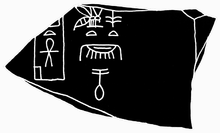Nubnefer
Nubnefer is the birth name of a king (pharaoh) who may have ruled during the 2nd dynasty of Ancient Egypt. The exact length of his reign is unknown and his chronological position is unclear.
| Nubnefer in hieroglyphs | ||||||
|---|---|---|---|---|---|---|
| Reign: unknown | ||||||
| Predecessor: unknown Successor: unknown | ||||||
Nisut-Bity Nubnefer nsw.t-btj nwb-nfr Birth name | ||||||
Name sources

The name "Nubnefer" appears on two black stone vessel fragments found in the Southern Galleries in the necropolis of king Djoser (3rd dynasty) at Sakkara, mentioning a building called "Menti-Ankh" ("Life may endure"), which was founded during the reign of king Nynetjer. Therefore, Egyptologists such as Peter Kaplony, Jochem Kahl and Francesco Tiradritti believe that Nubnefer's reign should be chronologically set close to that of Nynetjer. Nubnefer's name does not appear in any further contemporary or posthumous document.[1][2]
Identity
Egyptologists such as Battiscombe Gunn and Iorwerth Eiddon Stephen Edwards believe that the name "Nubnefer" could be the birth name of king Raneb. In contrast egyptologists such as Wolfgang Helck and Toby Wilkinson think that Nubnefer was the immediate successor of Nynetjer. Peter Kaplony identifies Nubnefer as a king who have ruled between the kings Wadjenes and Senedj.[1][3][4][5]
References
- Peter Kaplony: A building named Menti-Ankh. In: Mitteilungen des Deutschen Archäologischen Instituts Kairo, vol. 20. Deutsches Archäologisches Institut, Orient-Abteilung (Hrsg.). de Gruyter, Berlin 1965, page 41–46.
- Pierre Lacau & Jan-Phillip Lauer: La Pyramide à Degrés IV. – Inscriptions gravées sur les Vases: Fouilles à Saqqarah. Service des antiquités de l’Égypte, Cairo 1936, Table IV.
- I. E. S. Edwards: The early dynastic period in Egypt; Cambridge University Press, Cambridge 1964; page 25.
- And egyptologist Wolfgang Helck: Datierungen der Gefäßaufschriften aus der Djoser-Pyramide. In: Zeitschrift für ägyptische Sprache und Altertum, vol. 106. Akademie-Verlag, Berlin 1979, page 120–132.
- Toby Wilkinson: Early Dynastic Egypt: Strategy, Society and Security. Routledge, London 1999, ISBN 0-415-18633-1, page 89.